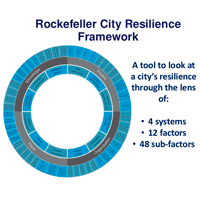City Resilience Framework
Developed by Arup with support from the Rockefeller Foundation, The City Resilience Framework (CRF) provides a lens to understand the complexity of cities and the drivers that contribute to their resilience, and a common language that enables cities to share knowledge and experiences.
The CRF is built on four essential dimensions of urban resilience: Health & Wellbeing; Economy & Society; Infrastructure & Environment; and Leadership & Strategy.
Each dimension contains three “drivers,” which reflect the actions cities can take to improve their resilience.
1. Leadership & Strategy
The processes that promote effective leadership, inclusive decision-making, empowered stakeholders, and integrated planning
- Promote Leadership and Effective Management
Encourage capable leadership and effective urban management within government and civil society, particularly during an emergency. This involves strong leadership, cross-sector communication, and evidenced-based decision-making.
- Empower a Broad Range of Stakeholders
Ensure everybody is well informed, capable, and involved in their city. This includes access to information and education, communication between the government and public, knowledge transfer, and timely and appropriate monitoring.
- Foster Long-Term and Integrated Planning
Align sectoral plans and individual projects with the city’s vision to be coordinated and appropriate to address the city’s needs. This includes city strategies and plans.
2. Health & Wellbeing
Everyone living and working in the city has access to what they need to survive and thrive.
- Meets Basic Needs
Particularly in times of crisis, ensure that people have access the basic resources necessary to survive – food, water and sanitation, energy, and shelter.
- Supports Livelihoods and Employment
Assist individuals to access diverse livelihood and employment opportunities, including access to business investment and social welfare. This includes skills and training, fair labor policy, and development and innovation.
- Ensures Public Health Services
Provide access to effective public healthcare and emergency services to safeguard physical and mental health. This includes medical practitioners and plans, as well as clinics and ambulances.
3. Economy & Society
The social & financial systems that enable urban populations to live peacefully, and act collectively.
- Promote Cohesive and Engaged Communities
Create a sense of collective identity and mutual support. This includes building a sense of local identity, social networks, and safe space; promoting features of an inclusive local cultural heritage; and encouraging cultural diversity while promoting tolerance and a willingness to accept other cultures.
- Ensure Social Stability, Security, and Justice
Ensure a comprehensive and inclusive approach to law enforcement and justice that fosters a stable, secure, and just society. This includes fair and transparent policing and deterrents to crime – specifically in times of crisis, as well as enforcement of laws such as codes and regulations.
- Foster Economic Prosperity
Ensure the availability of funding and a vibrant economy as a result of diverse revenue streams, the ability to attract business investment, and contingency plans. This involves good governance, integration with the regional and global economy and measures to attract investment.
4. Infrastructure & Environment
The man-made and natural systems that provide critical services, protect, and connect urban assets enabling the flow of goods, services, and knowledge
- Provide and Enhances Protective Natural and Man-Made Assets
Maintain protective natural and man-made assets that reduce the physical vulnerability of city systems. This includes natural systems like wetlands, mangroves and sand dunes or built infrastructure like sea walls or levees.
- Ensure Continuity of Critical Services
Actively manage and enhance natural and man-made resources. This includes designing physical infrastructure such as roads and bridges to withstand floods so that people can evacuate, as well as ecosystem management for flood risk management. It also includes emergency response plans and contingency plans that may coordinate airports to function so that relief can be lifted in and out during a crisis.
- Provide Reliable Communication and Mobility
Provide a free flow of people, information, and goods. This includes information and communication networks as well as physical movement through a multimodal transport system.

